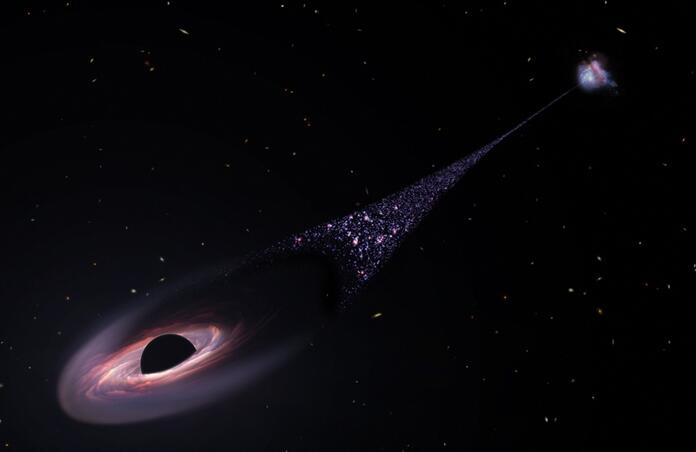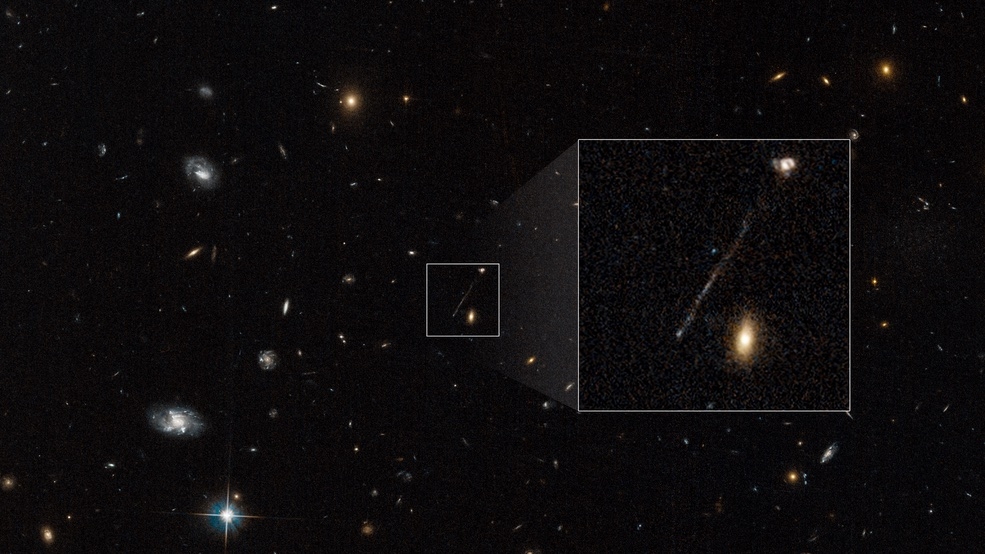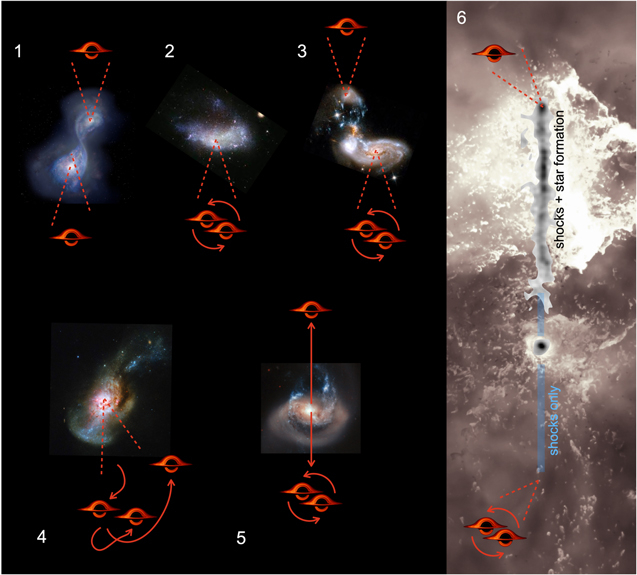Runaway black hole discovered from Hubble image

A rogue black hole has been spotted by astronomers, speeding away from the core of a distant galaxy at 20 million times the mass of the sun. The black hole is travelling so fast that if it were in our solar system, it could travel from Earth to the moon in just 14 minutes!
As the runaway black hole accelerates through space, the compression of dust and gas it encounters has left behind a line of new born stars spanning 200,000 light years. The star trail was first discovered by Pieter van Dokkum of Yale university. "We think we're seeing a wake behind the black hole where the gas cools and is able to form stars," explained van Dokkum, "What we're seeing is the aftermath. Like the wake behind a ship, we're seeing the wake behind the black hole." Despite the path being fairly thin, the high number of hot blue stars resulted in a brightness half the amount of the parent galaxy the black hole originates from.
Black holes do not emit light; however, their existence can be inferred from the disk of heated dust and gas surrounding them, denoted an accretion disk. These rotating disks emit radiation, which reveals the presence of a black hole. Nevertheless, the accretion disk was not the giveaway for this black hole. A strange streak connected to the nearby galaxy was noticed in an image taken by Hubble. Follow-up observations were taken using the Keck Observatory in Hawaii, confirming that there was in fact a trail.

(Credit: NASA, ESA, Pieter van Dokkum (Yale); Image Processing: Joseph DePasquale (STScI)).
van Dokkum was initially investigating another dwarf galaxy, however, stumbled onto the discovery by chance. "I was just scanning through the Hubble image and then I noticed that we have a little streak.” He says he initially almost dismissed it as an imaging artifact, but “[w]hen we eliminated cosmic rays we realized it was still there. It didn't look like anything we've seen before."
The team considered the possibility that the line was an astrophysical jet- material which is shot out from a black hole found in the centre of a galaxy. However, it was concluded that this is actually a trail of stars, since the streak gets stronger with distance from the galaxy, and doesn’t fan out at the end. The black hole is located at one end of the trail, along with a bright region of ionised oxygen at the tip. This is evidence of a shock wave in front of the black hole, since the motion of the black hole hitting the gas results in the gas being shocked and heated. It could also be due to radiation from the accretion disk. "Gas in front of it gets shocked because of this supersonic, very high-velocity impact of the black hole moving through the gas," said van Dokkum. "How it works exactly is not really known."

It is currently believed that the lone black hole was ejected from its host galaxy after two separate merger events, the first occurring around 50 million years ago. This merger resulted in two supermassive black holes taking orbits around each other. Later on, a third galaxy joined which disrupted the black hole pair (two’s company, three’s a crowd) which lead to one of the black holes being thrown from the system, along with the other two being ejected in the opposite direction.
To confirm this further, thus making this the first observational evidence of a supermassive black hole being ejected from its parent galaxy, the team plans to carry out follow-up observations using James Webb or the Chandra X-ray observatory.
--
Cover image: NASA, ESA, Leah Hustak (STScI)
Journal source: Dokkum et al., (2023), A Candidate Runaway Supermassive Black Hole Identified by Shocks and Star Formation in its Wake, ApJ, 946. doi:10.3847/2041-8213/acba86
